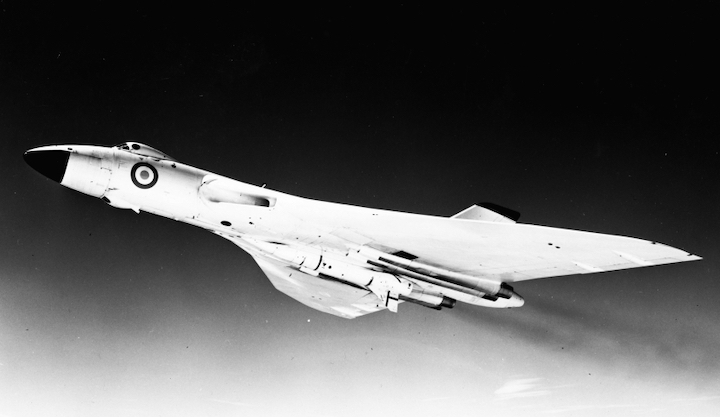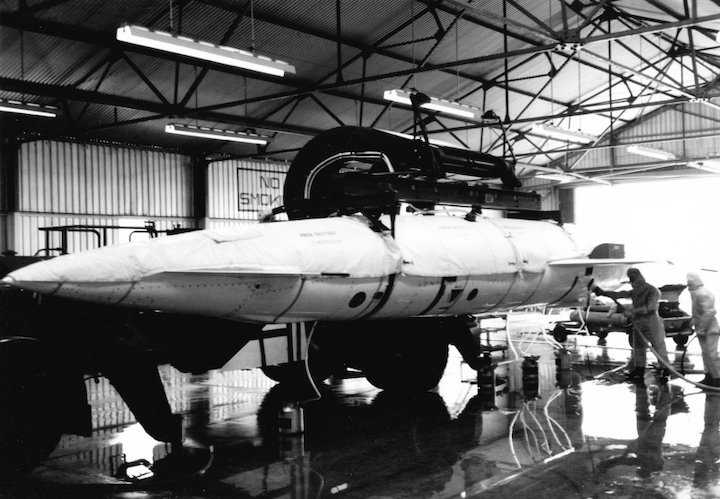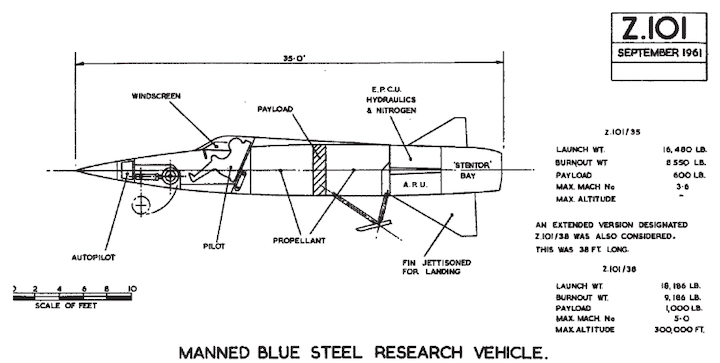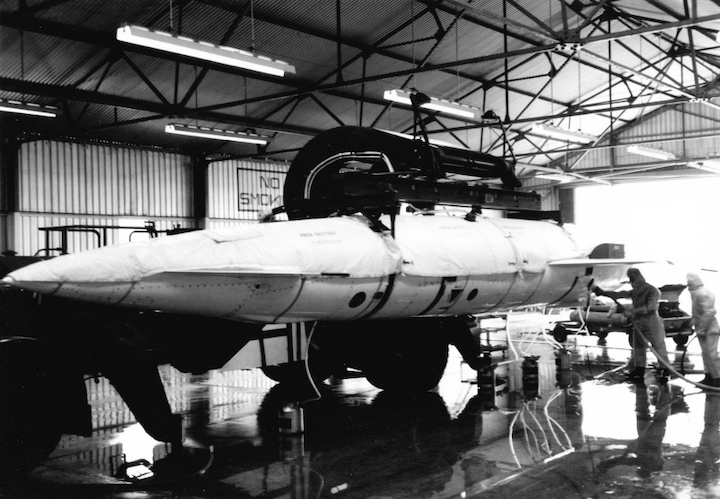3.11.2020

Avro Vulcan carrying a Blue Steel missile. The manned Blue Steel, Z.101, would have been carried in a similar fashion.
Cash-strapped Britain could only look on with envy during the late 1950s as massive investment fuelled a golden age of innovation and progress in US aviation and space technology. While the Americans were beginning to explore the furthest reaches of high-speed high-altitude flight with the spectacular Mach 5+ North American X-15 rocket plane, the British laid plans for a less flamboyant but no less ambitious experimental vehicle.
Blue Steel was designed after it became clear, in early 1953, that Soviet anti-aircraft defences would soon make it too dangerous for the RAF’s V-bombers to try dropping nuclear bombs directly onto their targets. It was a thermonuclear stand-off missile meant to be launched outside the maximum range of enemy defences before flying to its target at Mach 3 under its own internal guidance.
It needed to be the size of a small aircraft in order to accommodate Britain’s early nuclear warheads but still had to fit beneath an Avro Vulcan, Handley Page Victor or Vickers Valiant host aircraft. Avro itself won the contract to design it in March 1956 and by 1960 its final shape had been decided: a tubular fuselage 35ft 6¼in long with canards and stubby wings to the rear with a 13ft span.
The missile was powered by a two-chamber 22,000lb thrust Bristol Siddeley Stentor rocket motor which required kerosene fuel and high-test peroxide (HTP) oxidant. The use of HTP made Blue Steel difficult and dangerous to prepare for flight – during tests the area around the missile had to be thoroughly dowsed with water before fuelling and troughs of water had to be ready for ground crew to jump into in case they got any HTP on them.

Avro Blue Steel missile refuelling
Refuelling Blue Steel with HTP was a hazardous exercise and required floods of water to ensure any escaping liquid would be safely diluted.
Its Marconi-Elliott inertial navigation system was incredibly complex and somewhat unreliable. Avro’s decision to build Blue Steel out of, well, steel rather than titanium turned out to be a mistake and by 1960 the missile was seriously delayed due to constructional difficulties. Nevertheless, during this time Avro hatched a plan to offer Blue Steel as the basis for a manned experimental rocket plane – effectively a British counterpart to the X-15.

Manned Blue Steel
Avro drawing showing a basic outline of the Z.101 – the experimental manned Blue Steel research vehicle.
The project was named Z.101 and two versions were considered, Z.101/35 and the longer Z.101/38 (the /35 and /38 referring to the length of the vehicle in feet – by comparison, the X-15 was more than 50ft long). Converting Blue Steel into Z.101 would involve relatively minor changes. Its bulky navigation system would be replaced with a cockpit and a raised windscreen section would be added to the top of the fuselage. A nosewheel and basic autopilot would be installed in the nose and extendable skids would tuck up into the fuselage beneath the HTP tank. Removing the roomy warhead bay also made room for additional fuel tank capacity and a payload bay where measuring and other equipment could be fitted. The wings, control surfaces and motor remained unchanged.
Avro studied data on the X-15’s landing performance provided by the Americans, which gave a landing speed of 190 knots, and considered that this would be achievable for the Z.101. However, without the X-15’s wing flaps the Z.101’s nose would need to be raised up much higher on landing. A paraglider landing scheme was also therefore studied. Covert enquiries were made about possible landing sites in Australia and it was thought that Lake Carringallana in South Australia, a dry clay pan, would be suitable.

In its /35 form, Z.101 was expected to reach Mach 3.6 before its fuel gave out and in /38 it was intended to hit Mach 5 with a ceiling of 300,000ft. Avro aimed to achieve 10 flights with the Z.101 and believed that the project would have made a worthwhile contribution to high-speed high-altitude research, exploring the so-called ‘flight corridor’. But the X-15 was already flying and the Americans were happy to share the data it yielded. Z.101 would not have been ready before November 1965 and the idea was abandoned before September 1961.
Stripping out Blue Steel’s inertial navigator and replacing it with a human pilot would have removed Blue Steel’s biggest source of unreliability (though the problem of fuelling the vehicle would remain) but it would still have taken a brave test pilot indeed to climb aboard the steel missile and fly it up to Mach 5, not to mention bringing it back to earth for a perilous nose-up landing.
